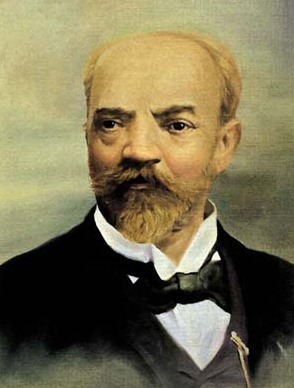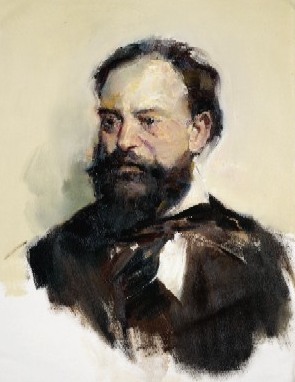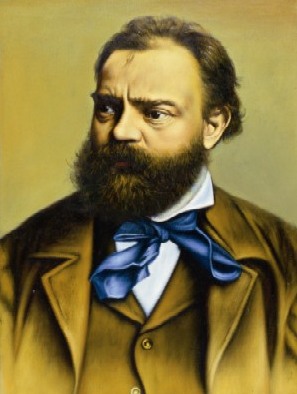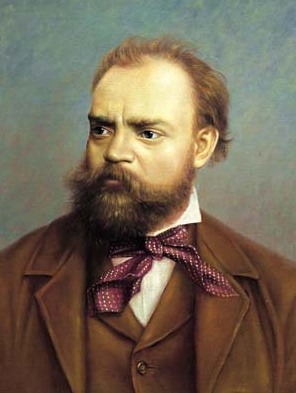
Portrait of Antonin Dvorák
Early career
Dvorák was born on September 8, 1841 in Nelahozeves, near Prague (then Austrian Empire, today the Czech Republic), where he spent most of his life. His father was a butcher, innkeeper, and professional player of the zither. Dvorák's parents recognized his musical talent early, and he received his earliest musical education at the village school which he entered in 1847. He studied music in Prague's only Organ School at the end of the 1850s, and gradually developed into an accomplished violinist and violist. Throughout the 1860s he played viola in the Bohemian Provisional Theater Orchestra, which from 1866 was conducted by Bedrich Smetana. The need to supplement his income by teaching left Dvorák with limited free time, and in 1871 he gave up playing in the orchestra in order to compose. During this time, Dvorák fell in love with one of his pupils and wrote a song cycle, Cypress Trees, that expressed his anguish at her marriage to another man. However in 1873 he married his pupil's sister, Anna Cermakova. They had nine children.
At about this time Dvorák began to be recognized as a significant composer. He became organist at St. Adalbert's Church, Prague, and began a period of prolific composition. Dvorák composed his second string quintet in 1875, and in 1877, the critic Eduard Hanslick informed him that his music had attracted the attention of Johannes Brahms, whom he later befriended. Brahms contacted the musical publisher Simrock, who as a result commissioned Dvorák's Slavonic Dances. Published in 1878, these were an immediate success. Dvorák's Stabat Mater (1880) was performed abroad, and after a successful performance in London in 1883, Dvorák was invited to visit England where he appeared to great acclaim in 1884. His Symphony No. 7 was commissioned for London; it premiered there in 1885. In 1891 Dvorák received an honorary degree from Cambridge University, and his Requiem Mass premiered later that year in Birmingham at the Triennial Music Festival.
America (1892–1895)
From 1892 to 1895, Dvorák was the director of the National Conservatory of Music in New York City, at a then-staggering $15,000 annual salary. The Conservatory had been founded by a wealthy and philanthropic socialite, Jeannette Thurber; it was located at 126-128 East 17th Street, but was demolished in 1911 and replaced by what is now a high school. Here Dvorák met with Harry Burleigh, one of the earliest African-American composers, although Burleigh was never his pupil. Burleigh introduced traditional American Spirituals to Dvorák at the latter's request.
In the winter and spring of 1893, while in New York, Dvorák wrote his most popular work, the Symphony No.9, "From the New World". He spent the summer of 1893 with his family in the Czech-speaking community of Spillville, Iowa, to which some of his cousins had earlier emigrated. While there he composed two of his most famous chamber works, the String Quartet in F (the "American"), and the String Quintet in E flat. In the same vein of American inspiration, he also wrote a Sonatina for violin and piano.
Over the course of three months in 1895, Dvorák wrote his Cello Concerto in B minor, which was to become one of his most popular works. However, problems with Mrs. Thurber about his salary, together with increasing recognition in Europe — he had been made an honorary member of the Gesellschaft der Musikfreunde in Vienna — and homesickness made him decide to return to Bohemia. He left New York before the end of the spring term. Dvorák's New York home was located at 327 East 17th Street near Perlman Place. It was in this home that the Ninth Symphony was written. Despite protests, from the then Czech President Václav Havel amongst others, who wanted the house preserved as a historical site, it was demolished to make room for a Beth Israel Medical Center residence for people with AIDS. To honor Dvorák, however, a statue of him was erected in Stuyvesant Square.
Later career
During his final years, Dvorák's compositional work centred on opera and chamber music. In 1896 he visited London for the last time to hear the premiere of his Cello Concerto. In 1897 his daughter married his pupil, the composer Josef Suk. Dvorák was director of the Conservatory in Prague from 1901 until his death in 1904. He is interred in the Vyšehrad cemetery in Prague. He left many unfinished works, including the early Cello Concerto in A major.
There are a few portraits in existence that were obviously painted from photographs of Dvorák. There also exists a portrait by A. Mitterfellner that was painted post mortem.

Photograph of Antonin Dvorak

Portrait of Antonin Dvorák

Portrait of Antonin Dvorák

Portrait of Antonin Dvorák
Since Dvorák traveled extensively and was a well-known composer, it is likely that portraits depicting this historical figure could exist virtually anywhere in the world, unknown and otherwise unauthenticated. Still wondering about a portrait in your family collection? Contact us... it could be a portrait of composer Antonín Leopold Dvorák.
